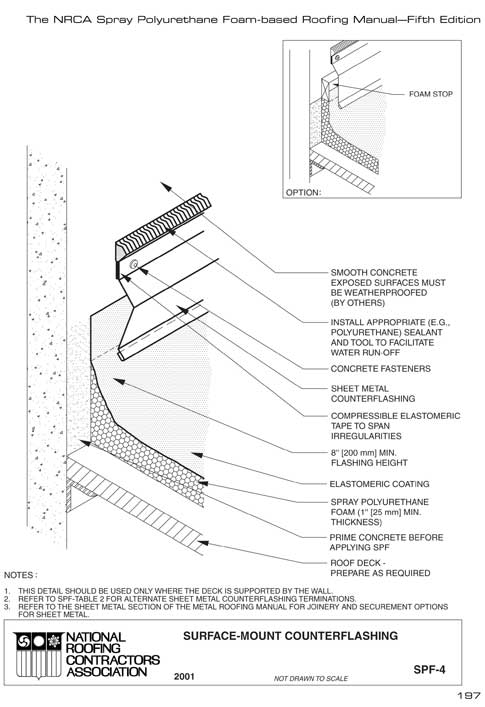NRCA recently released The NRCA Spray Polyurethane Foam-based Roofing Manual, 2006 Edition, which includes 30 revised spray polyurethane foam (SPF)-based roofing details, two new SPF details and updated ASTM International standard references relevant to SPF roof systems. The NRCA Spray Polyurethane Foam-based Roofing Manual, 2006 Edition, is the updated version of the stand-alone manual The NRCA Spray Polyurethane Foam-based Roofing Manual, Fifth Edition, which was published in 2003. Following are highlights of the changes.
Counterflashings
The manual's previous version, titled The NRCA Spray Polyurethane Foam-based Roofing Manual, Fifth Edition, has 65 SPF-based roof system details. Similar to the conventional roof system details in The NRCA Roofing and Waterproofing Manual, Fifth Edition, each vertical flashing detail has a metal counterflashing shown as a component. Fourteen details have been revised to include either an "Option" box in the upper-right-hand corner that depicts the detail without a sheet-metal counterflashing or the addition of "optional" in the reference note for a removable sheet-metal counterflashing. The reference note now says "Optional removable sheet metal counterflashing."
The primary rationale for the counterflashing changes was the information obtained during the second of two studies conducted by Structural Research Inc., Middleton, Wis., for the National Roofing Foundation. The study was titled "Phase II: Performance of Spray Polyurethane Foam Flashings" and included observations of 188 SPF-based roof systems ranging in age from new to 31 years of service. The study concluded SPF flashings performed as intended without the use of metal counterflashings and there was no purposeful need for counterflashings.
This report provided the basis for NRCA's acceptance of specific SPF details without the need for counterflashings. Although NRCA's primary focus is to provide conservative details, NRCA recognizes certain SPF details can perform successfully during the expected service life of a roof system without sheet-metal counterflashings. Figure 1 depicts a detail from The NRCA Spray Polyurethane Foam-based Roofing Manual, Fifth Edition. Figure 2 is the revised detail from The NRCA Spray Polyurethane Foam-based Roofing Manual, 2006 Edition.

Figure 1: Detail SPF-4 from The NRCA Spray Polyurethane Foam-based Roofing Manual, Fifth Edition.

Figure 2: Detail SPF-4 from The NRCA Spray Polyurethane Foam-based Roofing Manual, 2006 Edition.
Additional support for the change came from existing details. SPF-11, "Equipment Support Stand Support Column," and SPF-18, "Deck Supported Penetration," already were provided as details without sheet-metal counterflashings in The NRCA Spray Polyurethane Foam-based Roofing Manual, Fifth Edition.
Additional updates
An option also has been provided in detail SPF-8, "Roof System Divider." The base detail shows two roof systems divided by vertical wood blocking with a sheet-metal cap. The option provides for what essentially is a perimeter edge-metal flashing. The SPF-based roof is adhered to the vertical and top surfaces of the divider and ends at an embedded edge-metal flashing piece, much like SPF-2, "Perimeter edge metal flashing with sealant (foam stop)."
SPF-9, "Equipment Support Stand," also has a new option. The base detail shows vertical wood nailers covered with a sheet-metal cover. This assembly supports a vertical equipment leg. Instead of installing a sheet-metal cover over the vertical wood nailers, the option shows the SPF-based roof system installed up the vertical face and across the top of the nailers and up and around the equipment leg. The equipment leg must be installed before installation of the SPF-based roof system.
Because of the ability of SPF to be sprayed and formed to any shape, a new detail has been added as an alternative method for flashing vertical columns—SPF-15A, "Structural Member Through Deck," and its companion, SPF-15AS, the section view of the detail. It is critical the structural member and deck move with each other, so there is no differential movement between the horizontal and vertical substrates to which the SPF is adhered.
In addition, SPF-Table 4, "Guide for clearances between pipes," was revised. Although it still provides minimum recommended clearances between pipes, walls and curbs, it now includes a drawing providing direction for instances when adequate clearance is not included.
The 25 details with the wood "foam stop" have been revised—the wood "foam stop" component of the details was removed. Although the use of a foam stop is acceptable, this is not a detail used throughout the U.S.—it's a regional practice in California. It is NRCA's intention to promote details that are used throughout the U.S. while recognizing regional practices do exist but are not included in NRCA's manuals.
The 2006 manual update also includes two additions in Section 3.3.2.3, Types of Elastomeric Coatings. References to ASTM D3468, "Standard Specification for Liquid-Applied Neoprene and Chlorosulfonated Polyethylene Used in Roofing and Waterproofing," and ASTM D6694, "Standard Specification for Liquid-Applied Silicone Coating Used in Spray Polyurethane Foam Roofing," were added to the text discussing Hypalon™ and silicone coatings.
Final thoughts
The premise of the construction detail revisions is not to downgrade the performance of SPF roof systems or reduce the conservatism of NRCA's recommendations for SPF detailing. The intent is to bring NRCA's details to a level of conservatism that matches details that are performing and have performed well in the field for a number of years.
NRCA will continue to update and improve its documents and details as it has for more than 30 years.
The revisions included in The NRCA Spray Polyurethane Foam-based Roofing Manual, 2006 Edition, also are part of the 2006 update to The NRCA Roofing and Waterproofing Manual, Fifth Edition. See "Updating the manual," page 18, for more information about the 2006 update.
James R. Kirby, AIA, is an NRCA senior director of technical services.
